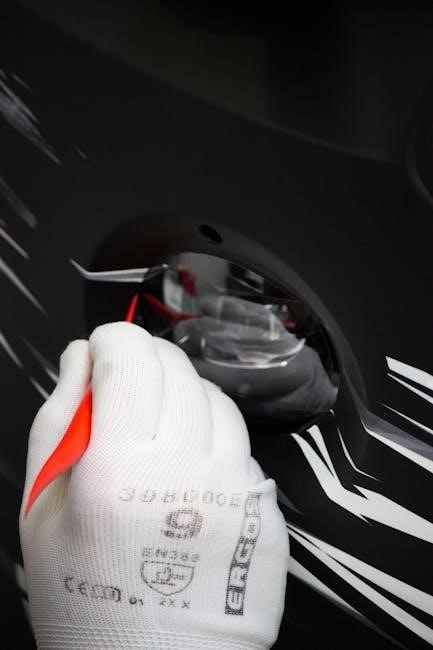Learning decal application is essential for a successful installation process using various tools and techniques properly every time with great patience and attention to details always required.
Understanding the Importance of Proper Application
Proper application is crucial for a successful decal installation, as it affects the overall appearance and longevity of the decal. A well-applied decal can enhance the aesthetic of a vehicle or surface, while a poorly applied decal can lead to peeling, fading, or other issues. Understanding the importance of proper application can help individuals achieve professional-looking results and avoid common mistakes. By following the correct techniques and using the right tools, individuals can ensure a strong bond between the decal and the surface, resulting in a durable and long-lasting finish. This requires attention to detail, patience, and practice, but the end result is well worth the effort, as a properly applied decal can make a significant difference in the overall appearance of a vehicle or surface. Proper application is essential for achieving a high-quality finish.

Preparing the Surface for Decal Application
Cleaning the surface is necessary for decal application to ensure a strong bond and proper adhesion always with great care and attention to details required every time.
Cleaning the Surface to Ensure a Strong Bond
Cleaning the surface is a crucial step in the decal application process, as it ensures a strong bond between the decal and the surface.
Using a mild detergent and water, scrub the surface to remove any dirt, grime, or oils that may interfere with the adhesion of the decal.
A soft cloth or sponge should be used to avoid scratching the surface, and the area should be rinsed thoroughly with clean water to remove any remaining dirt or detergent.
Allowing the surface to dry completely before applying the decal is also important, as any moisture can weaken the bond between the decal and the surface.
By following these steps, you can ensure a strong and lasting bond between the decal and the surface, and a successful decal application.
Proper cleaning and preparation of the surface are essential for a successful decal application.

Tools Needed for Decal Application
Scissors and squeegee are necessary tools for applying decals correctly every time with great patience always required for best results and outcome.
Using a Decal Application Squeegee and Other Essential Tools
A decal application squeegee is a crucial tool for applying decals, as it helps to remove air bubbles and excess water from the decal. Other essential tools include scissors, a credit card, and a plastic spatula. These tools can be used to apply pressure to the decal, ensuring it adheres properly to the surface. It is also important to have a clean and flat surface to work on, as this will help to prevent air bubbles and other issues. By using the right tools and techniques, you can achieve a professional-looking decal application. The squeegee should be used in a zig-zag pattern to ensure the decal is applied evenly and smoothly. This will help to prevent wrinkles and air bubbles from forming under the decal. With the right tools and a little practice, you can become proficient in decal application.
Applying the Decal to the Intended Surface
Apply the decal to the surface using a zig-zag pattern with a squeegee for proper adhesion always ensuring a smooth finish every time with great care and patience.
Using a Zig-Zag Pattern to Ensure Proper Adhesion
Applying a decal to a surface requires careful consideration to ensure proper adhesion, and using a zig-zag pattern is a crucial step in this process. By applying the decal in a zig-zag pattern, you can ensure that the decal is properly aligned and that there are no air bubbles or wrinkles. A squeegee is typically used to apply the decal, and it is essential to use a smooth, even motion to avoid applying too much pressure, which can cause the decal to stretch or distort. The zig-zag pattern also helps to prevent the decal from becoming misaligned, which can lead to a poor finish. With patience and attention to detail, using a zig-zag pattern can help to ensure a successful decal application. This technique is widely used and recommended by experts in the field of decal application.

Removing the Transfer Tape and Backing
Remove the transfer tape and backing layer carefully after applying the decal to the surface using a gentle pulling motion always.
Prepping the Sticker and Removing the Backing Layer
To ensure a smooth decal application process, prepping the sticker is crucial. This involves rubbing firmly across the transfer tape to prep the sticker, using fingers or a squeegee or credit card. The transfer tape is the transparent layer on top of the vinyl sticker, and rubbing it helps the vinyl stay on the transfer tape instead of coming off when removing the backing. It is essential to lay the sticker on a smooth, flat surface while doing this. The goal is to make sure the vinyl sticker is properly prepared for application, and the backing layer can be removed without causing any issues. Proper preparation and removal of the backing layer are vital steps in the decal application process, and they require attention to detail and care. Following these steps carefully will help ensure a successful application.

Troubleshooting Common Decal Application Issues
Resolving decal issues requires patience and attention to details always checking for errors and finding solutions quickly and effectively every time with great care and precision always.
Resolving Issues with Decal Transfer and Adhesion
To resolve issues with decal transfer and adhesion, it is essential to identify the root cause of the problem, whether it is due to incorrect application, poor surface preparation, or low-quality decals. Using a decal application squeegee or credit card to apply pressure can help ensure a strong bond between the decal and the surface; Additionally, increasing the heat for a longer period can also help with decal transfer. It is also crucial to follow the manufacturer’s instructions and take necessary precautions to avoid damaging the decal or the surface. By taking these steps, you can effectively resolve issues with decal transfer and adhesion, ensuring a successful application every time with great care and precision always, and a professional-looking result that lasts long. Proper techniques and patience are key to success.